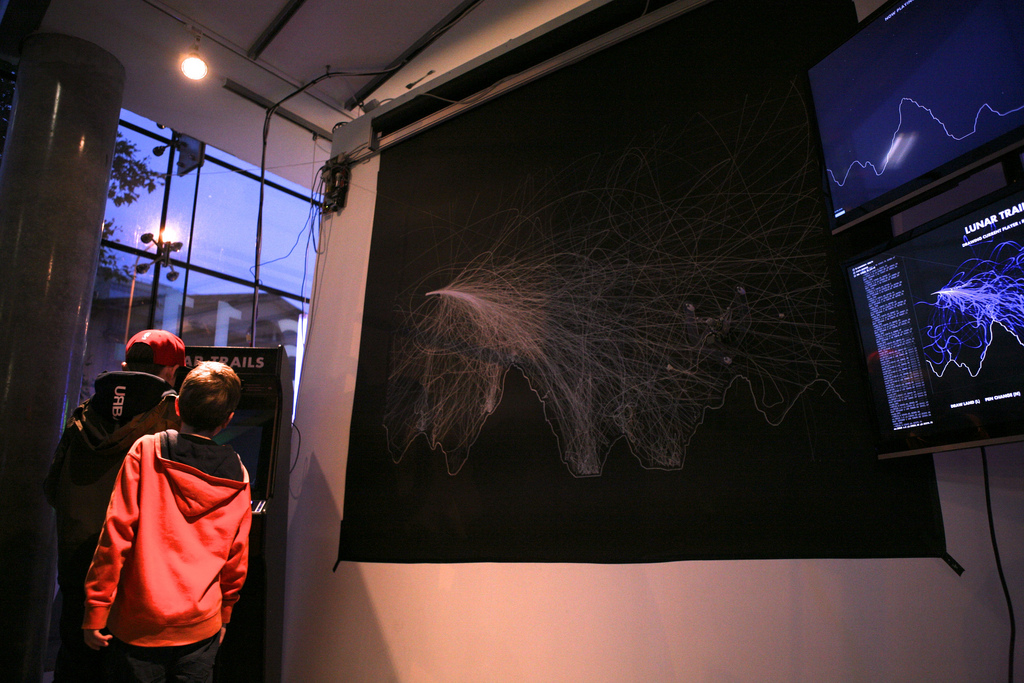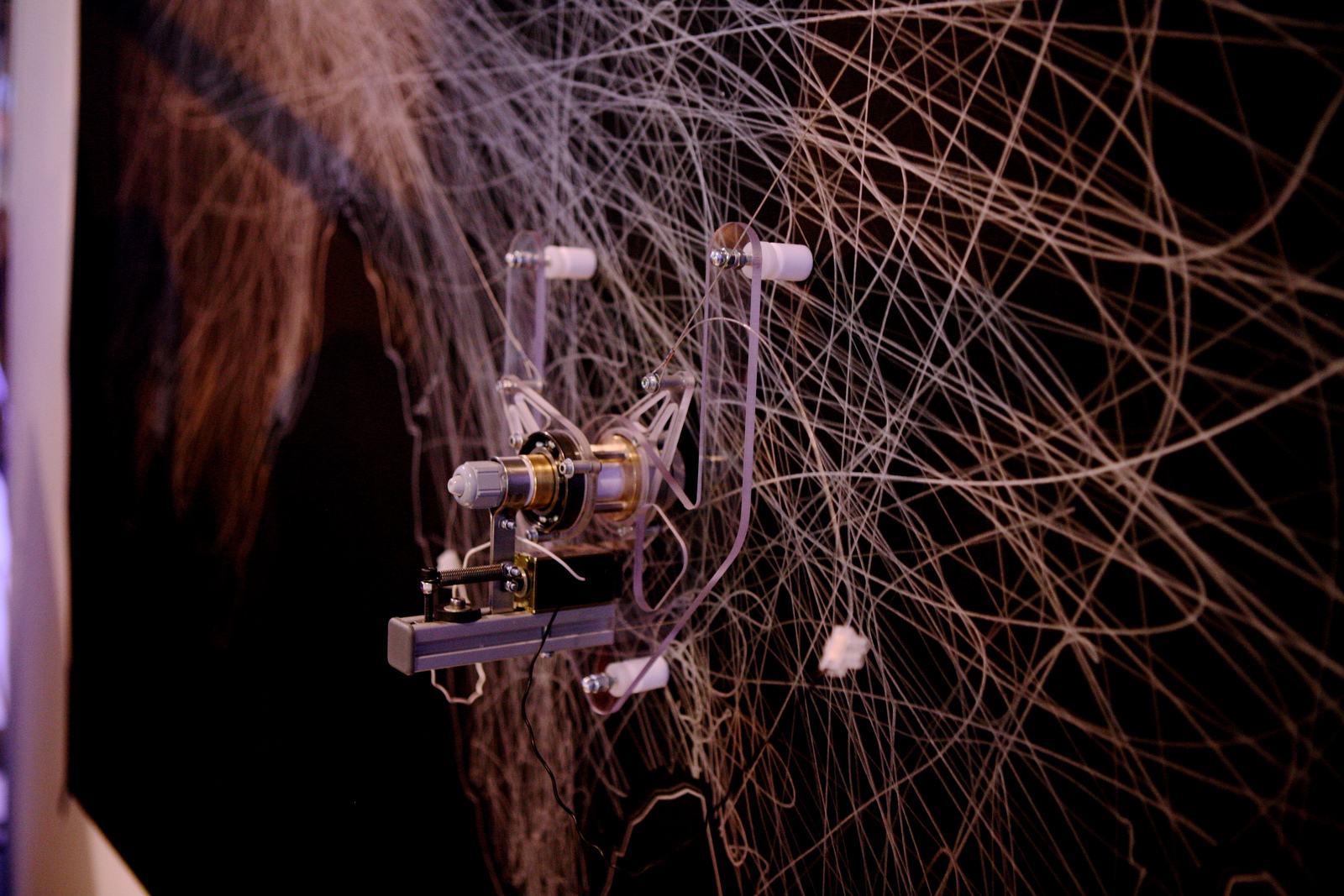Seb Lee-Delisle, the accidental programmer

Photo by Stefan Nitzsche
This interview was originally published on Makezine.com
The last 12 months have been a busy time for Seb Lee-Delisle. With a buzzing schedule of speaking, creative coding workshops, exhibitions and public events, it looks like this is the year he’s found his feet as a digital artist.
Just a few years ago, his career looked very different. After hopping around various creative digital disciplines, from desktop publishing to music production, he began to carve out a career in multimedia production for the web. A growing client list led him to set up his own agency, Plug-in Media. But client work began to take its toll:
“We were doing probably the best work you could imagine, very creative, for high-profile clients, but the thing I realised was, even with the best clients, I only spent about 10% of my time doing the stuff I really wanted to do, and the other 90% negotiating, in meetings, scheduling, budgeting, and team management – all this extra stuff, which I wasn’t that interested in doing. It was frustrating; I just wanted to do that 10%.”
Like many creative people drawn into business, Seb was looking for a way to get back to the work that he found fulfilling.
“I had an epiphany. I was doing interesting work, interactive websites, but I was struggling to do the things that I wanted to do: exploration, research, blogging, conferences, etc. because I had this huge responsibility [as the agency’s technical director]. I realised that if I started doing workshops, just one or two, I wouldn’t be that well off, but I’d have enough money to live off. Then I could do whatever I wanted the rest of the time, and not worry about money.
So that’s where I headed, and maybe a year later, that’s where I was.”
Accidental programmers
The workshops Seb started (and still runs) are creative JavaScript courses, where artists and designers can learn how to use code to create interactive visuals, multimedia and games.
Seb’s interest in code as tool for visual expression can be traced back a long way:
“I learned to program first when I was 11 on a Commodore Pet. Back then, all I really wanted to do with computers was make pictures and animations – little games and stuff. I didn’t have Photoshop, so if I wanted to make anything like that happen, I had to program it. So really my entire motivation for programming was to make visual things happen. And that’s been my motivation ever since.”
Many software engineers, game designers and digital makers look back to the 1980s as a golden age of accessible creative technology. Home computers were cheap, and easy to program, and a generation of hackers was born. But as the complexity of PCs increased, so did the tools for creating software and interactive content. In later years, if you wanted to create something with your computer that could stand up against the kinds of games or graphics you might consume on it, you were in for a steep learning curve.
But as the web emerged as a multimedia platform in the late 1990s and 2000s, a new generation of tools were developed that made programming accessible again.
“Flash is really important. If you think back to early 2000s, Flash was really hot. It was responsible for so many accidental programmers. It was a tool for artists and animators, and as the script side of it became more mature, people – artists – thought “What’s this code stuff?” and came to coding through that.
There’s not anything really like that any more. So with my creative JavaScript courses, often I’ll have experienced JavaScript programmers, but they haven’t done any of that visual stuff; they’re from the opposite end. I’m trying to get these artists and coders to converge in the middle, because I think that’s the interesting place where all the cool stuff happens.”
Meaningless without other people
One of Seb’s first independent projects was called Pixel Phones, an audacious attempt to turn a roomful of smartphones into a giant display.
Often demoed at tech conferences, Pixel Phones makes use of the small networked computers many of us carry in our pockets.
Participants load the app (which runs in a web browser) on their phones, and raise them to face a camera on stage. Each phone sends out a unique series of flashes which allows the system to track the position of each phone, and creates a giant, addressable display. From here on, the display possibilities are endless, from room-sized graphics, to animations and mass participation games.
Of course, a project like Pixel Phones requires a few hundred phones to test, making it difficult to develop, and nerve-wracking to demo with a live audience. I asked Seb why he worked on such risky, participatory projects:
“I like to make projects that are meaningless without other people. I don’t want to it be just ‘here’s some things that I made’, but ‘here’s some things, but unless you contribute something, nothing’s going to happen.’”
This reliance on audience participation was truly put to the test in September 2012, when Seb unveiled a new project on the opening night of Brighton Digital Festival.
Pixel Pyros is a firework display that takes place on a huge outdoor projector screen. Instead of being set off remotely, these digital fireworks are controlled by participants, who touch glowing orbs of light on the screen to trigger rockets, explosions and patterns of light.

Photo by Brighton Digital Festival
“With Pixel Pyros, there aren’t any fireworks unless people come up and trigger them. I was really worried – I just looked back at my opening talk, to introduce the fireworks, and I could sense the anxiety in my voice, that actually nothing would happen. But in the end, I had nothing to worry about. Though I didn’t expect it, every single one of those triggers had someone there the whole time.”
A good time to be a maker
Seb rounded off 2012 with a project that, while still relying on the input of participants, has a somewhat different feel.
Lunar Trails is an installation, currently at the Science Gallery in Dublin, in which visitors can play a recreation of the classic 1979 arcade game, Lunar Lander. The objective of the game is simple: land your craft safely on the surface of the moon, negotiating the uneven terrain and conserving fuel. It can be tense, and requires some concentration, but the experience is strangely peaceful, in part due to the simple graphics and gameplay.
In Seb’s version, the game extends beyond the confines of the screen. A drawing robot is suspended on the wall next to the arcade cabinet, and plots your trajectory along with with previous attempts made by other pilots. The result is a beautiful, almost abstract layering of lines, that combines the clean vectors of digital art, with the sometimes chaotic trajectories of novice (or just out-of-practice) human pilots.


Photos by Seb Lee-Delisle
Lunar Trails was made possible by the community of makers sharing their code, skills and hardware designs on the internet, and in hackspaces around the world. To translate the position data from the game into drawing instructions for the plotter, Seb adapted the code from another homebrew plotter project called Polargraph. And he worked with engineer Paul Strotten to build a custom plotter frame and servo drives at the local hackspace, Build Brighton.
The accessibility of development and prototyping tools, the ever-decreasing price of hardware, and of course the wealth of knowledge shared on the web, has enabled independent digital artists like Seb to experiment and realise their ideas in ways that would have been difficult even just 10 years ago.
“I’m pleased that we live now in this time, when it’s easy to get a camera, it’s easy to get a computer, and projectors are getting cheaper and cheaper.
And the internet, the accessibility of information – I wouldn’t have a clue how to do any of this stuff without it. So I think it’s a good time to be doing this. Especially because I like to work on my own, with low budgets. If I didn’t have access to equipment and knowledge, I’d have to get people with money, and therefore with some sort of desire to control. I think I’m really lucky. It’s a good time.”
You can find out more about Seb Lee-Delisle on his website, or follow him on Twitter.
Andrew Sleigh lives and works in Brighton, and is a co-founder of Brighton Mini Maker Faire. He’s a sucker for plotters. You can follow him on Twitter too.